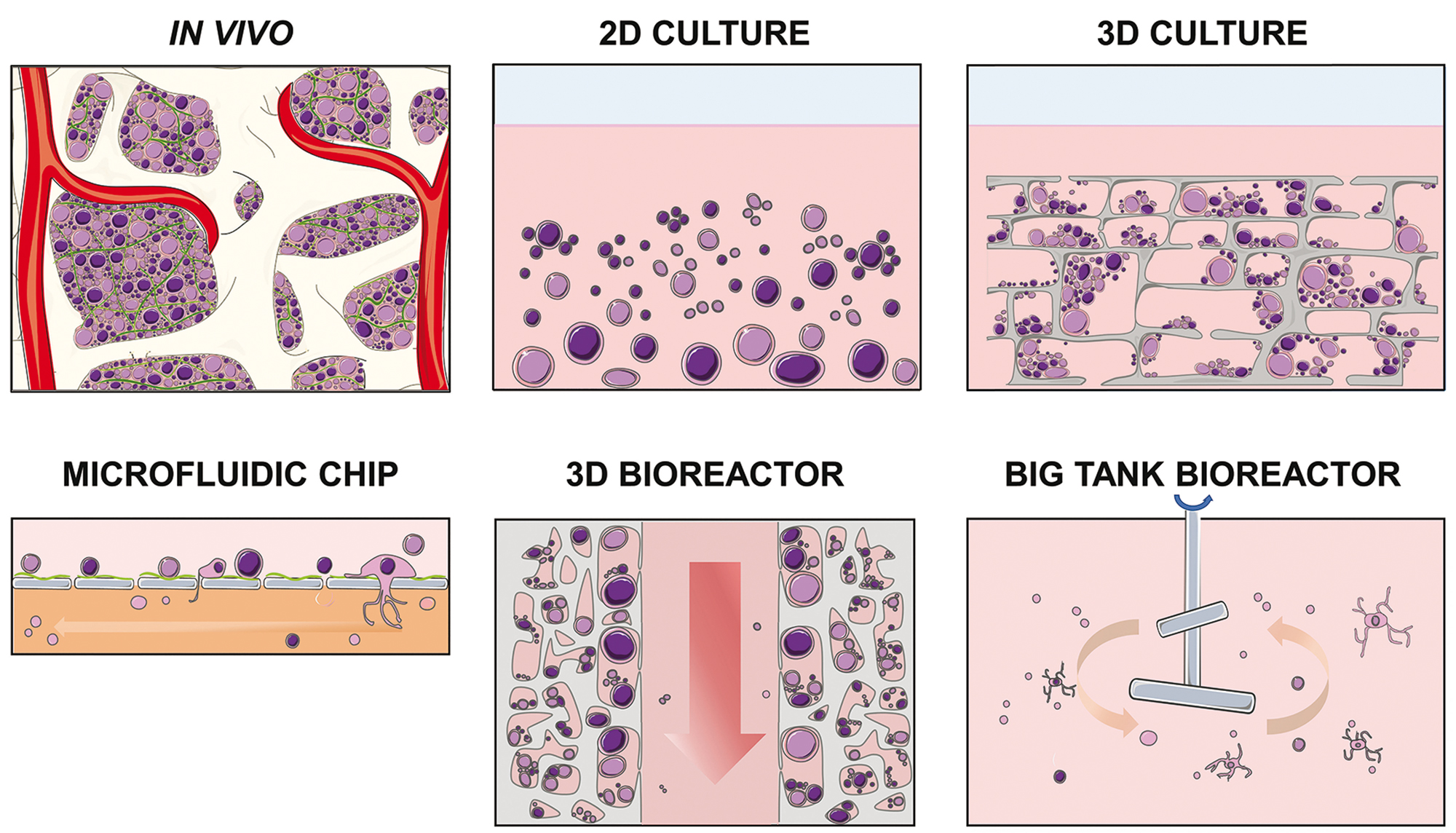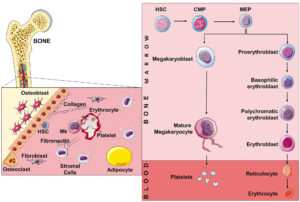
Blood cells in 3D cell culture
In recent decades there has been a strong move from 2 dimensional cell cultures to 3D cell culture systems as a laboratory tool to recapitulate the morphology of native human tissues. 3D cell culture systems has been quite challenging to the bone marrow due to its unique structure and complex mechanical features within the bone cavity (Knight and Przyborski, 2015).
Development of different blood cells
Human blood consists of red blood cells (erythrocytes), white blood cells (leukocytes) and platelets (thrombocytes). These 3 types of cells constitute 45% of total blood volume with the remaining 55% consisting of plasma. Hematopoiesis is the process of blood cell formation from hematopoietic stem cells (HSCs) that reside in the medulla of the bone marrow. It is a highly regulated by soluble and environmental factors that work together in a framework called the hematopoietic niche (Birbrair et al, 2016). The final stages of hematopoiesis are tightly controlled by different environmental cues that include cell-cell and cell-matrix interactions. Platelet and erythrocyte production is influenced by the composition and stiffness of the extracellular matrix (Rieger et al, 2009). On the other hand in cancer, the tumor microenvironment plays an important role in hematological malignancies (Burger et al, 2009). Therefore accurate representation of the bone marrow and mimicking its microenvironment is of great value for basic physiological studies of erythrocyte production, transfusion medicine, and cancer and immune system disorder research (Di Buduo et al, 2021).

Modifiable 3D cell culture systems
To this end, several 3D cell culture systems have been developed that includes microfluidic devices, 3D bioreactors (agitated or stirred) has been used in large-scale production of erythrocytes and platelets in transfusion medicine (Di Buduo et al, 2021). In a pathological context, tumor cell lines such as RPMI (B-lymphocytes myeloma cell lines) can be efficiently cultured as spheroid aggregates, to effectively mimic the tumor environment (Lee et al, 2020). 3D cell culture systems is a rapidly evolving field, that holds much promise for the future of targeted therapies, as well as in drug discovery processes in hematological cancers.
References
- Knight E, Przyborski S.. Advances in 3D cell culture technologies enabling tissue-like structures to be created in vitro. J Anat. 2015; 227(6):746-756.
- Birbrair, Alexander; Frenette, Paul S. (1 March 2016). “Niche heterogeneity in the bone marrow”. Annals of the New York Academy of Sciences. 1370 (1): 82–96.
- Rieger MA, Hoppe PS, Smejkal BM, Eitelhuber AC, Schroeder T.. Hematopoietic cytokines can instruct lineage choice. Science. 2009; 325(5937):217-218.
- Burger JA, Ghia P, Rosenwald A, Caligaris-Cappio F. The microenvironment in mature B-cell malignancies: a target for new treatment strategies. Blood. 2009;114(16):3367-3375.
- Di Buduo CA, Aguilar A, Soprano PM, Bocconi A, Miguel CP, Mantica G, Balduini A. Latest culture techniques: cracking the secrets of bone marrow to mass-produce erythrocytes and platelets <i>ex vivo</i>. Haematologica 2021;106(4):947-957;
- Lee, YJ., Park, KS., Baek, B.J. et al. Apoptosis and necroptosis-inducing effects of arctigenin on nasal septum carcinoma RPMI-2650 cells in 2D and 3D culture. Mol. Cell. Toxicol. 16, 1–11 (2020)



